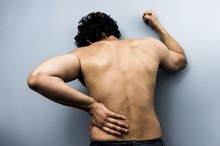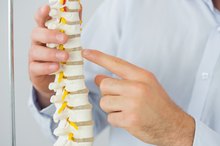What does fact checked mean?
At Healthfully, we strive to deliver objective content that is accurate and up-to-date. Our team periodically reviews articles in order to ensure content quality. The sources cited below consist of evidence from peer-reviewed journals, prominent medical organizations, academic associations, and government data.
The information contained on this site is for informational purposes only, and should not be used as a substitute for the advice of a professional health care provider. Please check with the appropriate physician regarding health questions and concerns. Although we strive to deliver accurate and up-to-date information, no guarantee to that effect is made.
A Diet for Spinal Stenosis
A diet for spinal stenosis should promote the health of your vertebral bones, discs, nerves and back muscles 1. In spinal stenosis, degeneration of the bones and ligaments in your spine may cause compression of your spinal cord and nerves, primarily in your neck or lower back. Over time, spinal nerve compression may lead to pain, tingling and weakness in your legs, back, shoulders or neck. Managing the pain of spinal stenosis requires maintaining correct posture, keeping up your physical activity and eating a well-balanced diet that provides energy while helping you control your weight.
Carbohydrates and Fats
Although diet can’t change the structure of your spine, maintaining a healthy weight can relieve pressure on your back and reduce leg pain and numbness when you’re going about your daily activities, Spine-Health states. A healthy, balanced diet should include generous portions of vegetables and smaller portions of fruits and whole-grain foods, such as pasta, bread or brown rice.
Protein
Weight Loss After Lumbar Fusion
Learn More
Eating foods that contain protein, such as:
- chicken
- fish
- beef
- eggs
- nuts
- dairy products
- gives you the basic materials for maintaining muscle tissues
The muscles and ligaments in your back support and stabilize your spine and help you maintain correct posture. The Centers for Disease Control and Prevention states that in general, men over age 19 need 56 g of protein each day, and women over 19 need 46 g of protein daily. Your protein needs may vary according to your age and activity level. To keep your weight within a healthy range, your diet should emphasize low-fat sources of protein such as fish or poultry. Choose lean cuts of meat, trim any visible fat and remove skin from poultry before eating.
- Eating foods that contain protein, such as: * chicken
* fish
* beef
* eggs
* nuts
* dairy products
* gives you the basic materials for maintaining muscle tissues The muscles and ligaments in your back support and stabilize your spine and help you maintain correct posture. - To keep your weight within a healthy range, your diet should emphasize low-fat sources of protein such as fish or poultry.
Vitamins and Minerals
Meeting your daily requirements for essential vitamins and minerals may reduce inflammation in your spine and minimize pain, according to Spine-Health. Eating foods that are rich in these nutrients may promote the health of your vertebrae, connective tissues and nerves. Vitamin C contributes to the formation of spinal ligaments, which stabilize your back while you stand, sit, bend or walk. The B-complex vitamins promote nerve function and blood circulation to your spine. Calcium serves as the major mineral component of bones and may help prevent vertebral degeneration. Vitamin D helps your body absorb calcium.
- Meeting your daily requirements for essential vitamins and minerals may reduce inflammation in your spine and minimize pain, according to Spine-Health.
- The B-complex vitamins promote nerve function and blood circulation to your spine.
Fluids
How to Repair a Bulging Disk
Learn More
Drinking adequate fluids will help your spinal discs stay hydrated, Spine-Health notes. These discs provide cushioning between your vertebrae and facilitate movement in your spinal joints. Hydration benefits your discs by contributing to their fluid content. To keep up your fluid intake, drink water and other calorie-free or low-calorie beverages throughout the day. Limit or eliminate caffeinated drinks and alcohol, which may leave you dehydrated.
- Drinking adequate fluids will help your spinal discs stay hydrated, Spine-Health notes.
- These discs provide cushioning between your vertebrae and facilitate movement in your spinal joints.
Related Articles
References
- Spine-Health: Posture and Nutrition Adjustments for Lumbar Stenosis
- Spine-Health: Controlling Degenerative Disc Disease Pain
- American Academy of Orthopedic Surgeons. Lumbar spinal stenosis. Updated December 2013.
- MedlinePlus. Foraminotomy. Updated November 5, 2018.
- Cleveland Clinic. Spinal stenosis: Overview. Updated August 17, 2020.
- Lurie J, Tomkins-lane C. Management of lumbar spinal stenosis. BMJ. 2016;352:h6234. doi:10.1136/bmj.h623
- Cleveland Clinic. Spinal stenosis: Overview. Updated August 17, 2020.
Writer Bio
Anne Tourney specializes in health and nutrition topics. She is a registered nurse with experience in medical-surgical nursing, behavioral health and geriatrics. Tourney earned a Bachelor of Science in nursing from Regis University.









